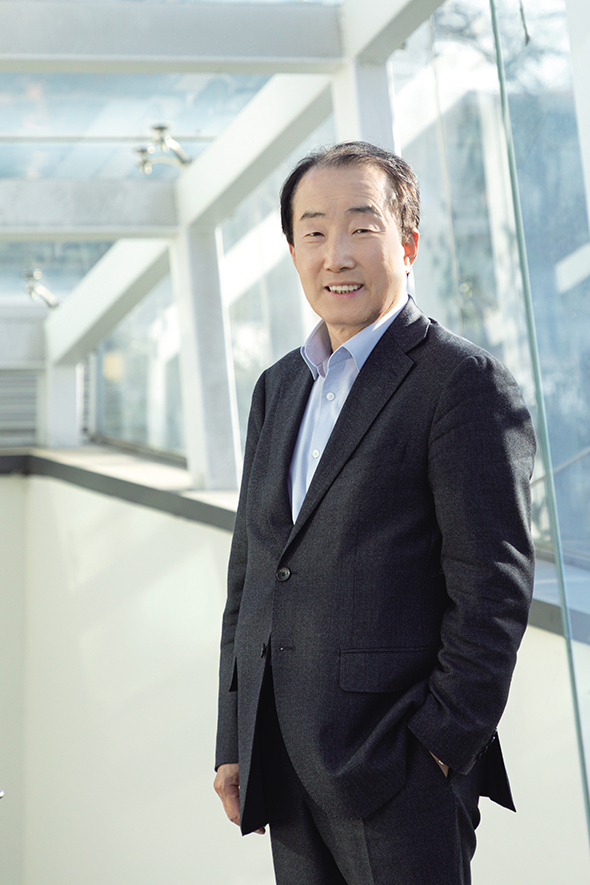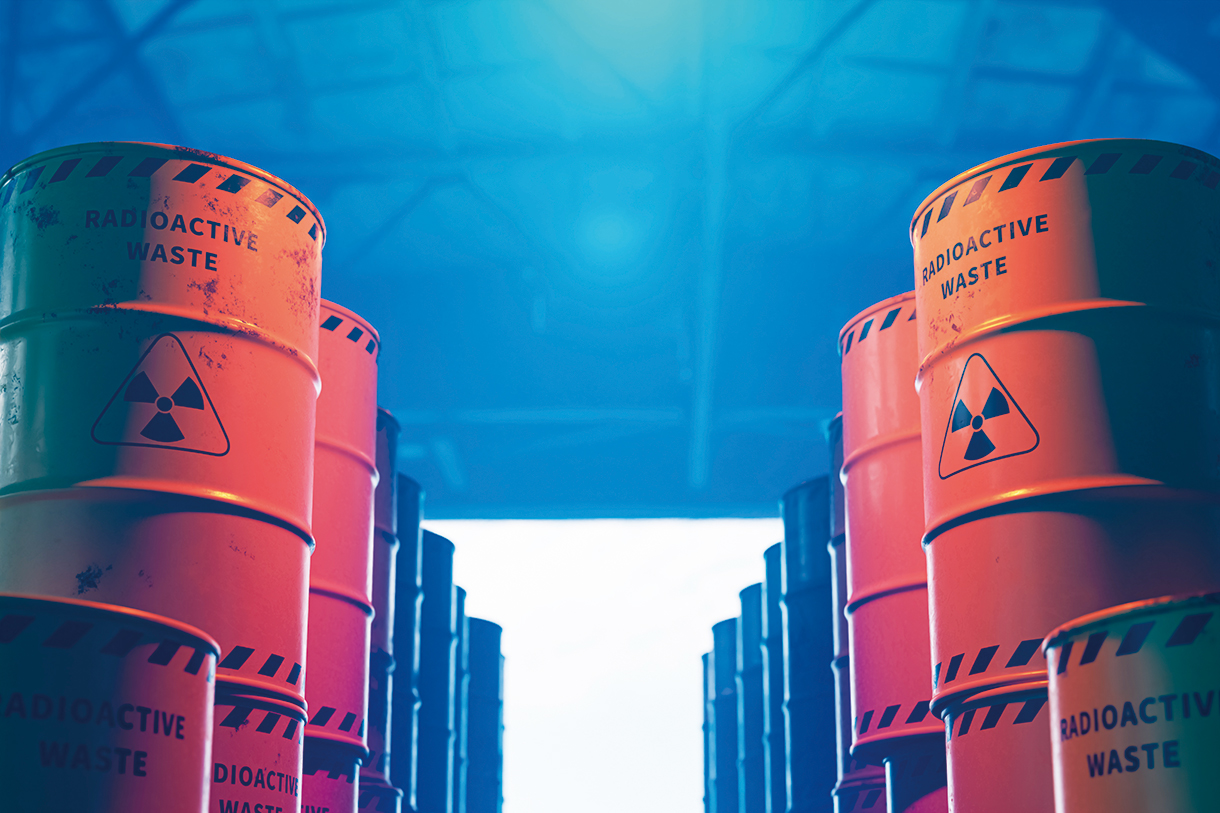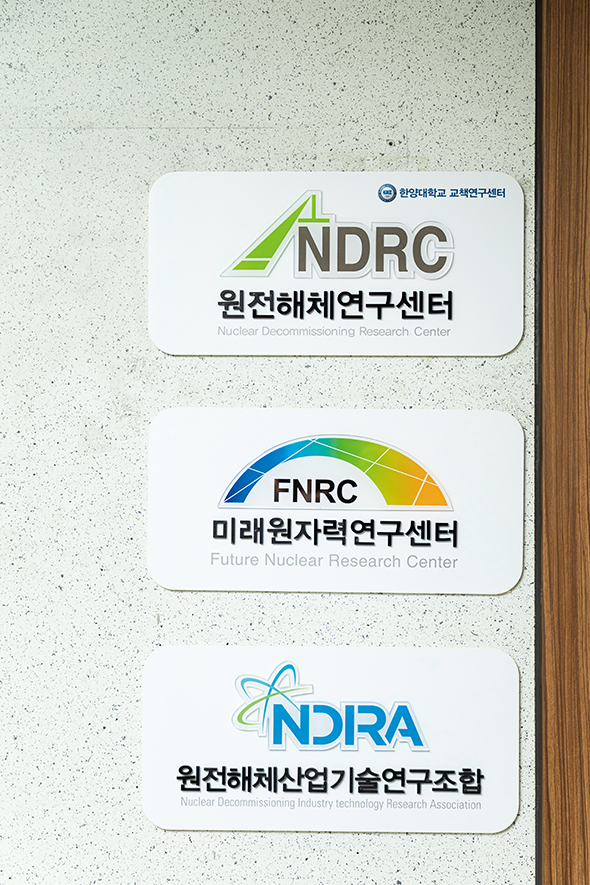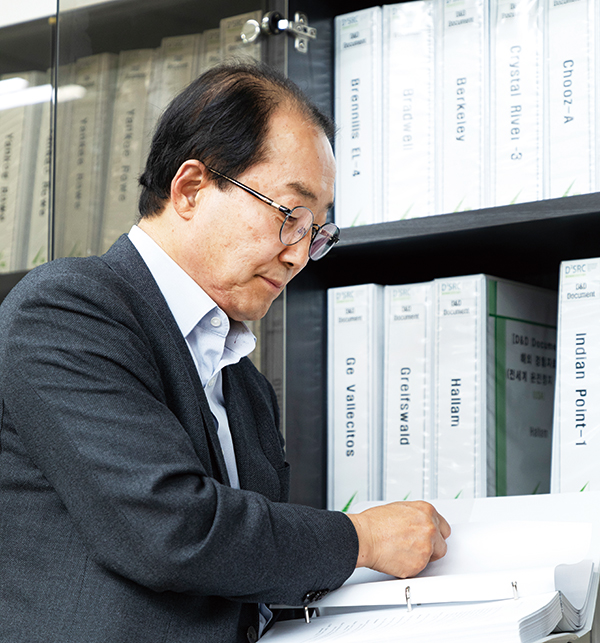

Story
건설·운영만큼 중요한 원전 해체
미래 산업 선점할 혜안 필요
Nuclear Decommissioning: Just as Crucial as Construction and Operation
A Vision to Lead the Future of the Industry
원전해체연구센터장 김용수 교수(원자력공학과 명예교수 겸 특임 연구교수)
Professor Kim Yong-soo, Director of the Nuclear Decommissioning Research Center
(Emeritus Professor and Research Professor, Department of Nuclear Engineering)
- 글 김현지
- 사진 이현구
- Writing Kim Hyun-ji
- Photograph Lee Hyeon-gu
Scroll Down
Everything in life has a beginning and an end. Each individual is born into the world, leave their mark through their respective roles, gradually age, and eventually fade away. Just like living beings such as plants, animals, and microorganisms, so too do inanimate objects. Items and facilities, once worn and aged, eventually reach the end of their lifespan. We spoke with Professor Kim Yong-soo, the Director of the Nuclear Decommissioning Research Center, about “nuclear decommissioning,” the process that oversees the final phase of aging nuclear power plants.

원전의 설계 수명은 40년, 그 이후는?
현재 원자력 발전은 전 세계 총 전력의 약 10%를 공급하고 있다. 상업용으로 운영됐거나 운영 중인 원전은 세계 31개국 430여 기에 이른다. 원전의 설계 수명을 40년으로 간주하면, 현재 전 세계 원전의 약 ⅓ 이상이 설계 수명이 다했거나 경제·기술적 이유로 인해 영구적으로 운전이 정지된 상태다. 1978년 4월 운전을 시작한 우리나라 최초의 상업용 원자로 ‘고리원전 1호기’도 이미 지난 2017년 가동을 중단했다.
“인류가 이렇게 많은 원전을 건설하고 운전했다면, 이제 자연스럽게 임무를 마치고 퇴역하는 원전이 나오기 마련입니다. 현재 전 세계에서 가동을 멈춘 원전은 170여 기에 달합니다. 원전 해체란 노후된 원전이 영구적으로 가동을 중단한 뒤 그 원전을 흔적도 없이 없애는 것을 말합니다. 원전 내 방사능 오염을 안전하게 제거하고 시설과 부지를 철거하는 모든 과정을 아우르죠. 우리나라는 아직 원전 해체를 진행한 경험이 없지만, 세계적으로는 이미 20기가 해체된 바 있습니다.”
원전 해체는 건설과 반대로 원전 내에 존재하는 방사성 물질을 하나하나 제거하면서 계통과 구조물을 차례로 철거하는 과정이다. 기본적으로 원전이 아예 없었던 자연 상태로 복원하는 게 목표다. 물론 일부 시설을 활용하고자 완전 해체와 다른 방향으로 진행할 수도 있다. 어떤 방향이든 원전 해체에서 중요한 것은 원전 해체가 원전 건설의 역순이 아니라는 것이다.
“핵분열로 에너지를 발생시키는 과정 중 여러 방사성 물질이 만들어집니다. 고리 1호기와 같이 원전을 40년간 가동했다면, 그동안 만들어진 방사성 물질이 원전 내 여기저기에 쌓였다고 볼 수 있어요. 따라서 해체 대상 원전의 어디에, 어떤 방사성 물질이, 얼마만큼 존재하는지를 알아야 안전하게 해체할 수 있습니다. 단순히 관련 시설을 없애는 것이 아니기 때문에 원전 해체는 원전 건설의 역순이 아니며, 함부로 할 수 없습니다.”
김용수 교수는 원전 해체 과정에서 가장 중요한 것이 해체 원전에 대한 방사선학적 특성평가라고 말한다. 이 결과를 바탕에 둬야, 비로소 어떤 순서로 어떻게 해체하고 어떤 식으로 방사성 물질을 제거할지 등의 계획을 수립할 수 있다고 설명했다. 이 과정에는 수십 년 전 과거의 운전 이력까지 반영돼야 한다. 국부적 오염 사건 등 어떤 방사선학적 이슈가 있었는지 알아야 하기 때문이다. 방사능 오염 제거는 한 번에 끝나지 않는다. 여러 차례 반복해야 한다. 국제적으로 경험이 쌓이며 그 기간이 줄어들고는 있지만 평균 10~12년 정도가 소요된다. 따라서 원전 해체는 방사능과의 싸움이자 불확실성(Uncertainty)과의 싸움이다.
The Design Life of Nuclear Power Plants is 40 Years—What Comes After That?
Currently, nuclear power generation supplies approximately 10% of the world’s total electricity. There are approximately 430 nuclear power plants that have been or are currently being operated commercially in 31 countries worldwide. Considering that the design lifespan of most nuclear power plants is approximately 40 years, more than one-third of these plants have either reached the end of their design life or have been permanently shut down due to economic or technical reasons. The first commercial nuclear reactor in Korea, ”Kori Unit 1,” which began operations in April 19”78, ceased operations in 2017.
Given that humanity has constructed and operated numerous nuclear power plants, it is only natural that some of these nuclear power plants are now reaching the end of their operational life and retiring,” explains Professor Kim Yong-Soo. “Currently, approximately 170 nuclear power plants worldwide have ceased operations. Nuclear decommissioning refers to the process of permanently dismantling these plants so that no trace remains. This includes safely removing radioactive contamination, dismantling facilities, and restoring the site. While South Korea has not yet decommissioned a plant, around 20 nuclear power plants globally have already been dismantled.” Decommissioning involves a step-by-step removal of radioactive materials and dismantling of systems and structures within the plant. The ultimate goal is to restore the site to its original natural state. However, depending on the situation, partial decommissioning may be pursued if some facilities can still be repurposed. Regardless of the approach, Professor Kim emphasizes that decommissioning is not simply the reverse process of construction.
“In the process of generating energy through nuclear fission, various radioactive materials are created. For a plant like Kori Unit 1, which operated for 40 years, radioactive substances would have accumulated throughout the facility. To safely decommission it, it’s essential to first identify where these materials are located, what types they are, and in what quantities. Since it is not simply about dismantling the related facilities, nuclear decommissioning cannot follow the reverse order of construction, nor can it be done carelessly,” Kim noted.
Professor Kim highlights that the most critical aspect of nuclear decommissioning is conducting a radiological characterization of the plant. This assessment serves as the foundation for planning the order of decommissioning, determining how to safely remove radioactive materials, and addressing other safety concerns. The process must also account for the plant's operational history, including any radiological incidents or localized contamination. Removing radioactive contamination is not a one-time task; it requires repeated efforts over several years. While international experience has helped reduce this timeline, the average decommissioning process still takes 10 to 12 years. “Decommissioning is a battle not only against radiation but also against uncertainty,” Kim added. It is a challenging and lengthy process that demands careful preparation, thorough assessment, and rigorous execution.


원전 해체는 400조 원 넘는 거대 시장
원전 해체의 안전성을 걱정하는 시선도 있지만, 앞서 말한 것처럼 이미 20기의 원전이 해체 완료됐다. 체르노빌이나 후쿠시마 원전과 같이 큰 사고가 발생하지 않고, 정상적으로 퇴역한 원전의 경우 해체 시의 위험성은 매우 낮은 편이다. 국제원자력기구(IAEA)는 원전 관련 사고를 0에서 7까지, 8개의 등급으로 나눈다. 이 체계를 빌려 말하자면, 후쿠시마 사고는 위험 등급이 최고 수준인 7등급이다. 원전 해체 시 발생 가능한 최대 사고는 1~2등급 정도다.
미국은 세계 최초로 1980년대에 이미 원전 해체를 시작했다. 지금까지 미국이 16기, 독일이 3기, 일본이 1기의 원전을 해체하며 선두 그룹을 차지하고 있다. 최근 영국이나 프랑스도 적극적으로 나서고 있지만, 아직 해체를 완료한 경험은 없다. 또 일본은 후쿠시마 원전 사고 이후 정상 퇴역한 원전 해체 경쟁에서 밀려나는 모양새다.
“이미 가동을 중단한 고리 1호기 외에도 2030년까지 국내 원전 11기가 설계 수명 만료를 앞두고 있습니다. 10년 내에는 전 세계 원전의 80% 이상이 영구 정지될 예정이죠. 기본적으로 원전 1기를 해체하는데 약 1조 원의 비용이 소요되니, 원전 해체 시장은 총 400조 원이 넘는 거대 시장입니다. 국가의 미래 경쟁력을 좌우할 큰 시장이지요. 지금 시기를 놓치면 국가적 전략 산업을 선도할 기회가 날아갈지 모릅니다. 안전하고 경제적으로 원전을 해체할 수 있는 경험과 실력을 길러야 해요.”
김용수 교수는 우리가 미리 대비하지 않으면 글로벌 경쟁력을 갖출 수 없고, 국내 원전의 해체까지 다른 나라에 장악당할 수 있다고 지적했다. 국가의 미래 먹거리를 잃는 것은 물론, 국민의 안전까지 다른 이의 손에 좌우되는 것이다. 원전 해체 분야에서 국제적 경쟁력을 확보하려면 어떻게 해야 할까? 고리 1호기 해체를 발판으로 실전 경험을 쌓고, 전문지식을 갖춘 우수 인력을 키워야 한다. 이제 막 열리는 세계 원전 해체 시장에 진출할 준비를 제대로 해야 한다.
“우리가 50년 전 원자력 발전을 시작할 때는 나라의 경제 상황이 어렵고 기술도 턱없이 부족했습니다. 해외에 의존할 수밖에 없었죠. 하지만 지금은 원전을 국산화하고 수출까지 해낸 원자력 강국이 됐습니다. 그간 쌓아 온 실력과 저력을 통해 선제적으로 대비해야 합니다. 건설, 운영, 정비, 해체에 이르는 원전 산업 전 과정을 책임질 수 있다면 엄청난 경쟁력이 될 것입니다.”
Nuclear Decommissioning: A Market Worth Over KRW 400 Trillion
While concerns about the safety of nuclear decommissioning persist, 20 reactors have already been successfully decommissioned. For reactors that have retired normally without major incidents, such as those at Chernobyl or Fukushima, the risks associated with decommissioning are relatively low. The International Atomic Energy Agency (IAEA) classifies nuclear-related incidents on an eight-level scale from 0 to 7. By this standard, the Fukushima accident was classified at the highest level, 7. In contrast, the maximum incident risk during decommissioning is typically in the 1–2 range.
The United States was the first to begin decommissioning nuclear power plants in the 1980s. To date, the U.S. has dismantled 16 reactors, Germany 3, and Japan 1, placing these countries at the forefront of nuclear decommissioning. While the UK and France have recently begun actively pursuing decommissioning projects, they have yet to complete any. Japan, meanwhile, has lost its competitive edge in decommissioning reactors that retired normally following the Fukushima disaster.
“In addition to Kori Unit 1, which has already ceased operation, 11 domestic reactors are set to reach the end of their design life by 2030. Globally, more than 80% of nuclear power plants are expected to be permanently shut down within the next decade. Decommissioning a single reactor costs roughly KRW 1 trillion, meaning the total market for nuclear decommissioning exceeds KRW 400 trillion. This is a colossal market that could determine a nation’s future competitiveness. If we fail to act now, we may lose the opportunity to lead this strategic industry. We need to build the expertise and capabilities to decommission reactors safely and economically.”
Professor Kim Yong-Soo warned that without adequate preparation, South Korea risks losing its global competitiveness in decommissioning, leaving the dismantling of its domestic reactors in the hands of foreign companies. This would not only jeopardize the country’s economic potential but also place the safety of its citizens at the mercy of external parties. How can Korea secure international competitiveness in nuclear decommissioning? According to Professor Kim, the decommissioning of Kori Unit 1 must serve as a foundation for gaining practical experience, cultivating highly skilled professionals, and preparing for entry into the emerging global nuclear decommissioning market.
“Fifty years ago, when we began nuclear power generation, our country was struggling economically and lacked sufficient technology. We had no choice but to rely on foreign expertise. But today, we have become a nuclear powerhouse, capable of domestic production and even exporting reactors. We must leverage the skills and resilience we’ve built over the years to proactively prepare. If we can take responsibility for the **entire nuclear lifecycle—from construction and operation to maintenance and decommissioning—we will gain tremendous competitive strength,” Professor Kim emphasized.

한양대는 국내 대학 최초로 원자력공학과를 설립한 데 이어, 국내 대학 최초이자 유일한 대학원 과정인 후행핵주기공학과를 만들어 원전 해체 분야를 선도할 인재를 키우고 있다
Hanyang University was the first in Korea to establish a Department of Nuclear Engineering and has since created the country’s only graduate program in Back-End Nuclear Cycle Engineering, cultivating talent to lead the field of nuclear decommissioning.

국가의 원자력 발전 이끌어 온 한양대
원전 1기를 해체하는 데 200~300명, 많게는 400~500명의 엔지니어와 전문가가 필요하다. 우리에게 절실한 것은 이 새로운 분야를 개척해 갈 인재다. 한양대는 국내 원자력공학을 견인해 온 주역이다. 1958년 한양대가 국내 대학 최초로 원자력공학과를 설립했는데, 이는 이승만 정부가 세운 원자력원·원자력연구소나 서울대 원자력공학과보다도 1년이 앞선 행보였다. 한양대 원자력공학과는 지난 65년간 학부 졸업생 2200여 명과 석사 400여 명, 박사 140여 명을 배출해 냈다. 원자력 분야 선구자들이 상당수 포함돼 있다.
“원전 건설이나 운영뿐 아니라 원전 해체 분야를 이끌 전문 인력 육성을 위해 공과대학장이던 2016년 공학대학원 내에 후행핵주기공학과를 설립했습니다. 국내 대학 최초이자 현재까지 유일한 학과죠. 이미 60여 명에 이르는 공학석사를 배출했습니다. 교책 연구센터인 원전해체연구센터도 활발하게 운영 중입니다. 12개 기업이 함께하는 산학 협동 센터로, 우리 연구진과 기업의 연구진이 함께 다양한 국책 및 산업체 연구 과제를 수행하고 있습니다.”
원자로 재료의 노화를 연구하다가 원전 해체 분야에 발을 들였다는 김용수 교수. 그는 국내 원전 해체 분야에서 독보적인 위치를 차지한다. 60여 편의 국제학술 논문을 통해 원전 해체 관련 여러 이론과 모델을 제시했고, 안전한 원전 해체를 위한 지침서도 펴냈다. 이를 바탕으로 대한민국 녹색기술대상 지식경제부 장관상, 세계인명사전 (Marquis Who‘s Who) 선정 올해의 과학자 및 앨버트 넬슨 평생공로상, 한국원자력학회 하나기술상, 대한민국 정부 근정포장 등 국내외의 인정을 받고 있다. 김용수 교수의 남은 목표는 원전해체연구센터를 원자력 분야 비영리 민간 연구소로 키워내, 원자력을 포함한 미래 에너지 분야 기술 개발을 선도하는 것이다.
“저는 학생들에게 늘 ‘높은 목표를 갖고, 멀리, 그리고 넓게 보라’고 말합니다. 그래야 새롭게 도전하고, 어려움을 극복해 성공할 수 있어요. 15년 전만 해도 원전 해체는 주요 이슈가 아니었습니다. 하지만 이제는 시각이 달라졌죠. 원자력 분야에서 우리나라가 이뤄낸 역사 안에는 미래를 내다본 선배들의 도전과 열정이 자리하고 있습니다. 이것을 잊지 말고, 젊은 세대가 그 도전과 열정을 이어가길 바랍니다.”
Hanyang University Leading the Country’s Nuclear Power Generation
Decommissioning a single nuclear reactor requires between 200 and 300 engineers and experts, and in some cases, as many as 400 to 500. What Korea urgently needs is a new generation of talent to lead this emerging field. In 1958, Hanyang became the first university in Korea to establish a Department of Nuclear Engineering—one year ahead of the Korea Atomic Energy Research Institute (KAERI) and the Department of Nuclear Engineering at Seoul National University, both created under President Rhee Syngman's administration. Over the past 65 years, the department has produced more than 2,200 undergraduate alumni, 400 master’s graduates, and 140 Ph.D. graduates, many of whom have become pioneers in the nuclear field.
“To foster specialists who can lead not only in nuclear power plant construction and operation but also in decommissioning, we established the Department of Back-End Fuel Cycle Engineering in 2016 within the Graduate School of Engineering. This was the first and remains the only such department in Korea. To date, we have produced over 60 master’s degree holders. Additionally, the Nuclear Decommissioning Research Center, a flagship research institute, is operating actively. It serves as an industryacademia collaboration center involving 12 companies, with our researchers and industry professionals working together on various government and industrial research projects,” explained Professor Kim Yong-Soo.
Professor Kim, who initially studied aging in nuclear materials before transitioning into nuclear decommissioning, has become a leading figure in the field. He has published more than 60 international academic papers, proposing numerous theories and models related to decommissioning. He has also authored guidelines for safe nuclear decommissioning. His contributions have earned him prestigious awards, including the Green Tech Award Grand Prize from the Ministry of Knowledge and Economy, the Albert Nelson Lifetime Achievement Award from Marquis Who’s Who, the Hana Technology Award from the Korean Nuclear Society, and the Service Merit Medal from the Korean government. Professor Kim’s ultimate goal is to transform the Nuclear Decommissioning Research Center into a nonprofit private research institute that leads technological development not only in nuclear energy but also in future energy fields.
“I always tell my students to aim high and think far and wide. Only then can they take on new challenges, overcome difficulties, and achieve success. Fifteen years ago, nuclear decommissioning was not a significant issue. But perspectives have changed. The history of Korea’s achievements in nuclear energy is built on the vision and passion of earlier generations who looked to the future. I hope the younger generation will carry forward that same spirit of challenge and innovation,” he shared.
